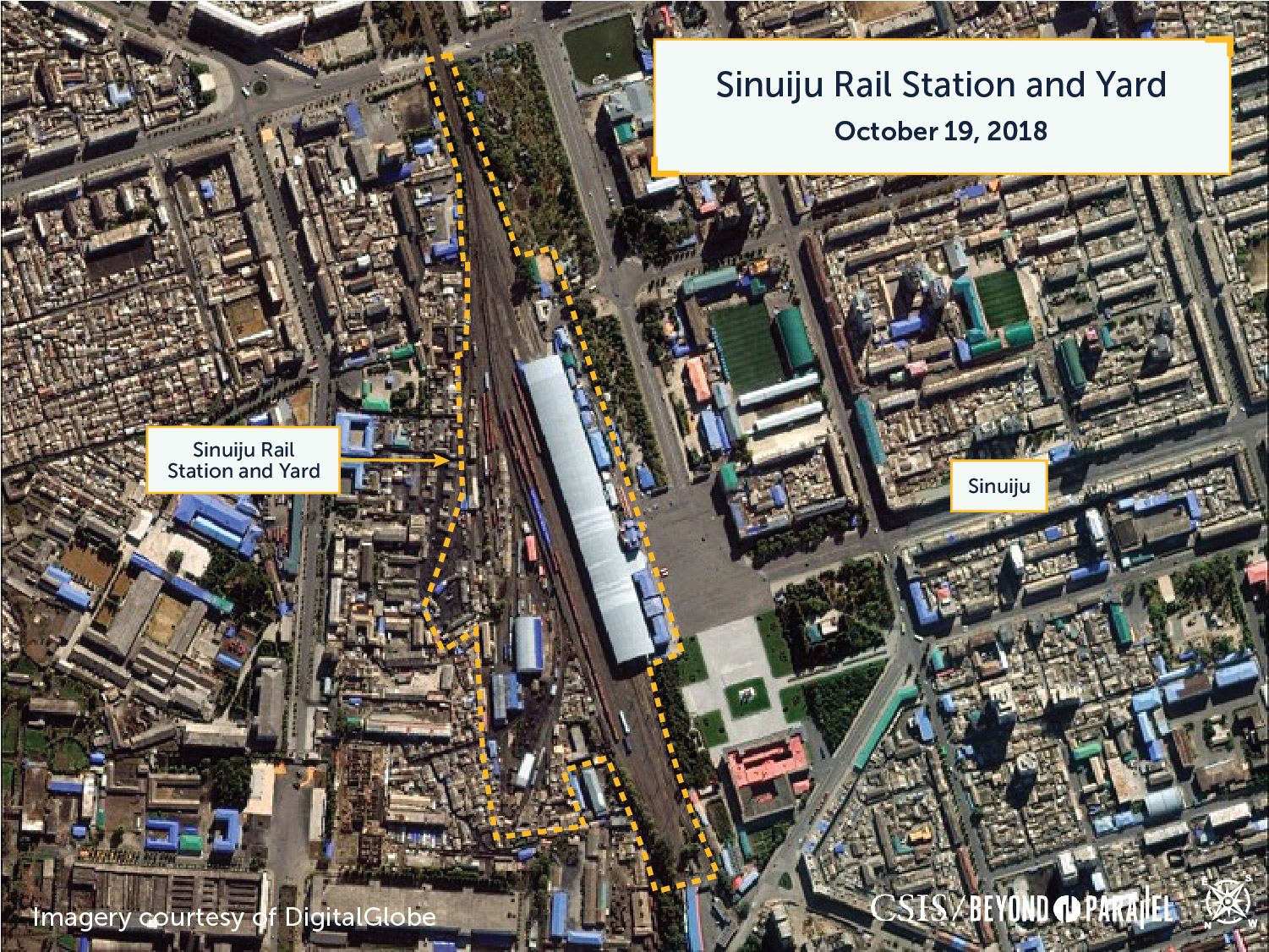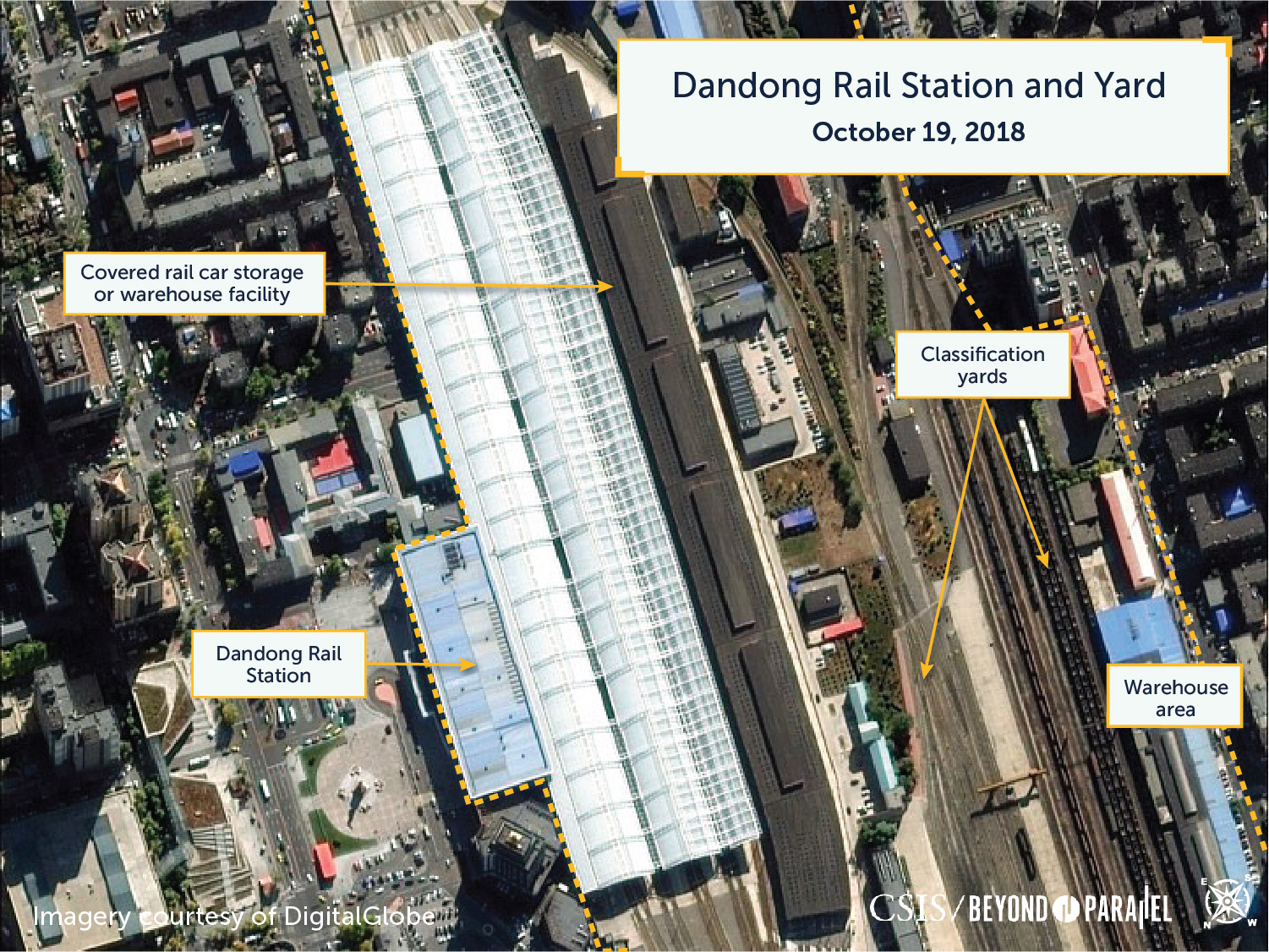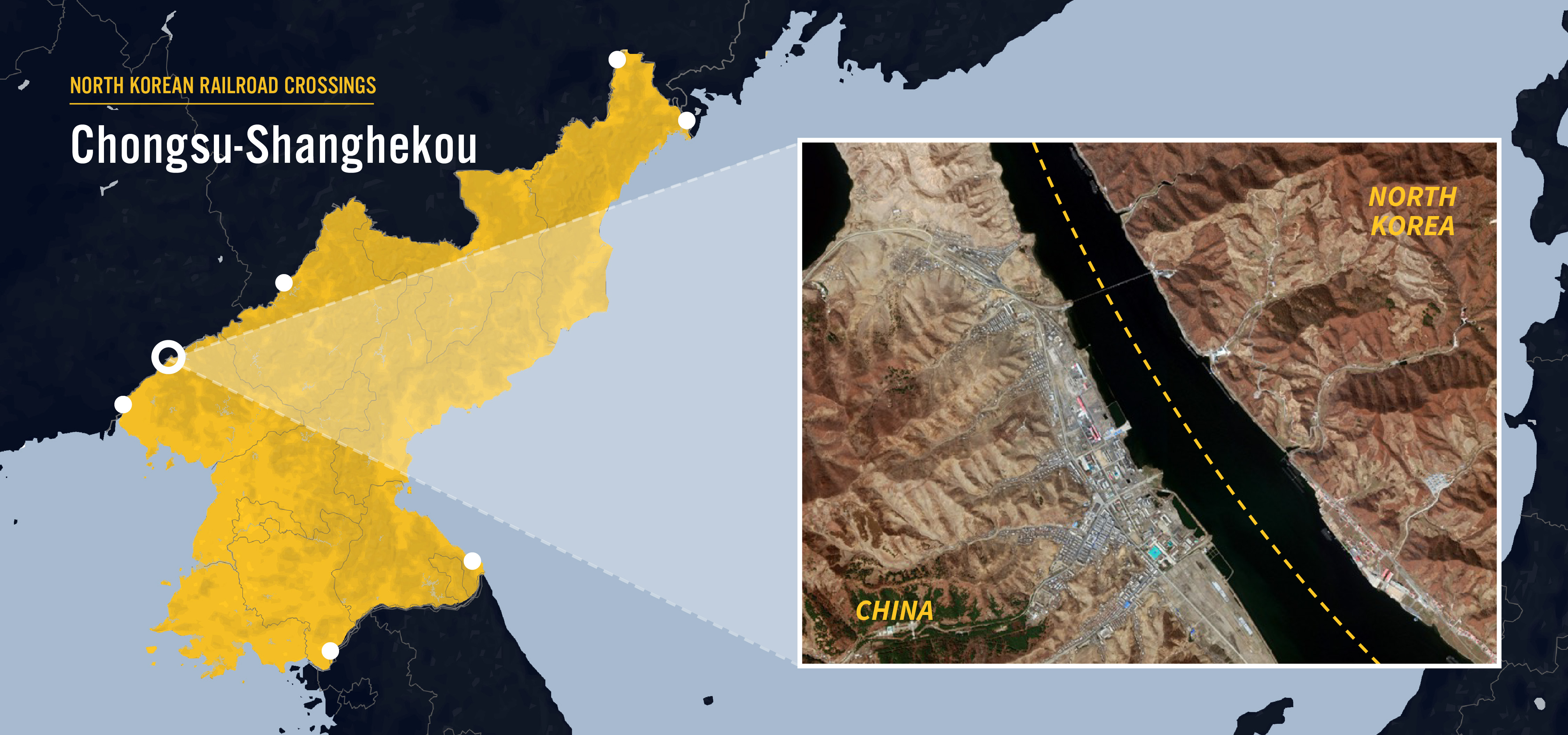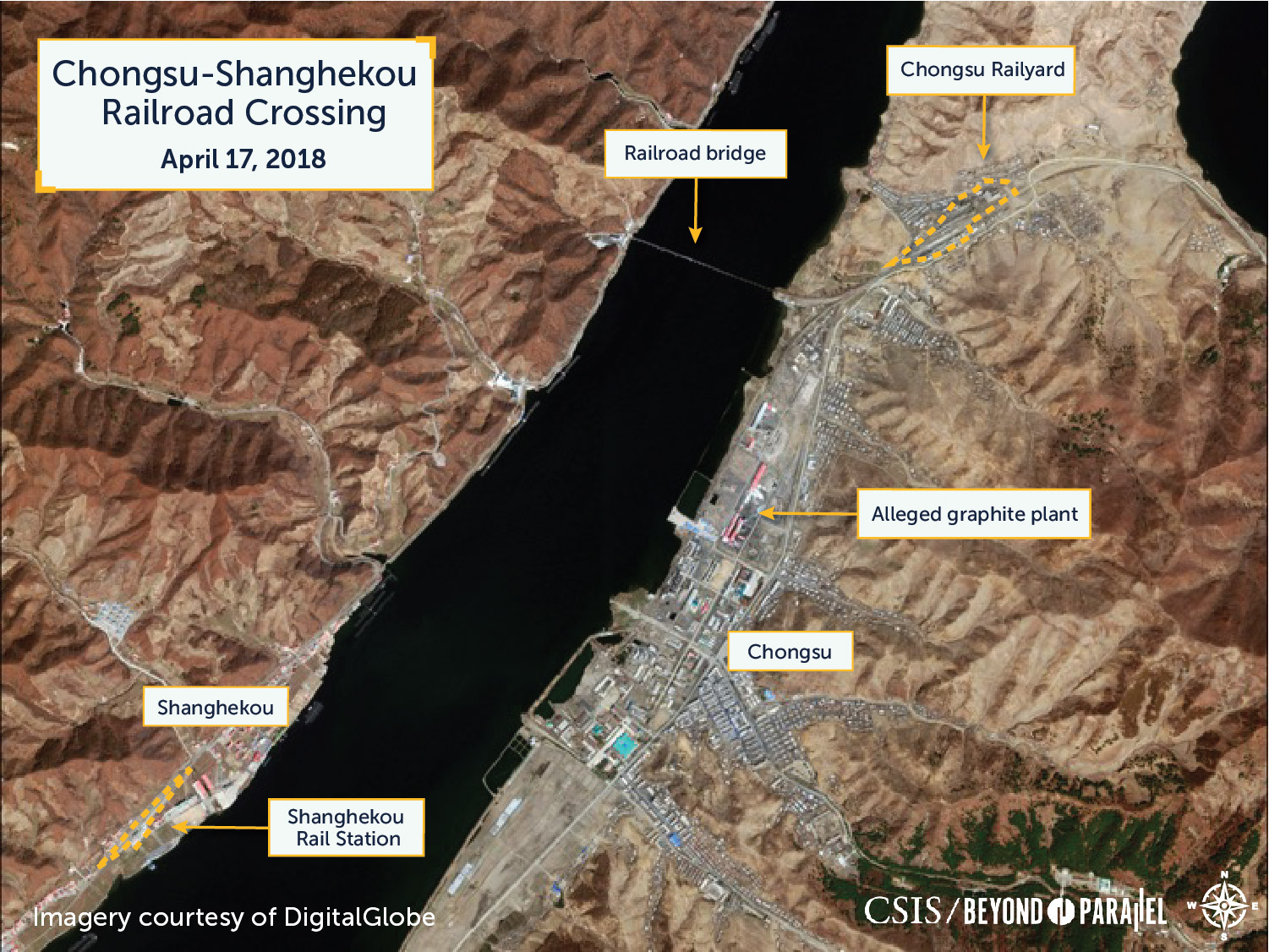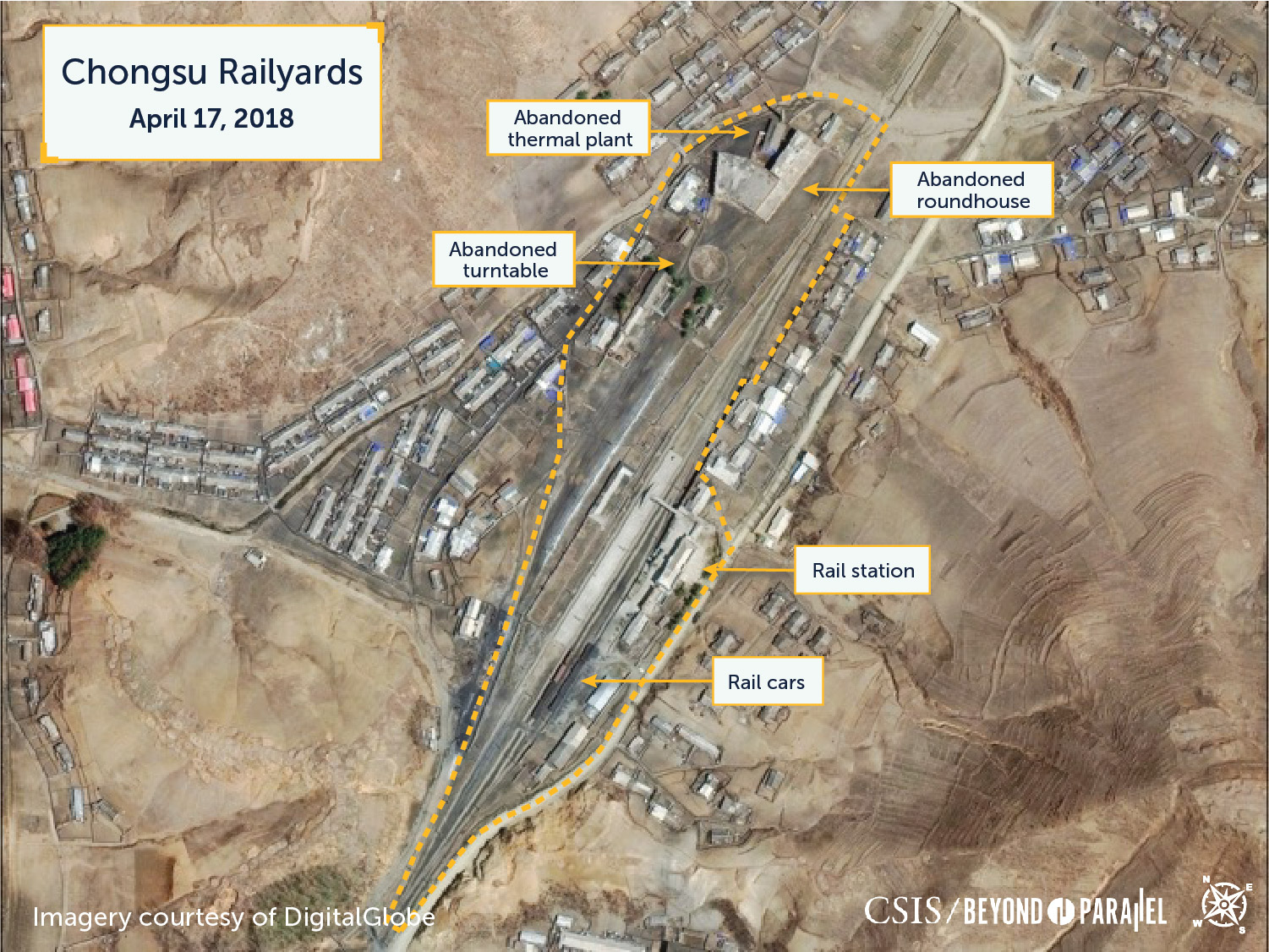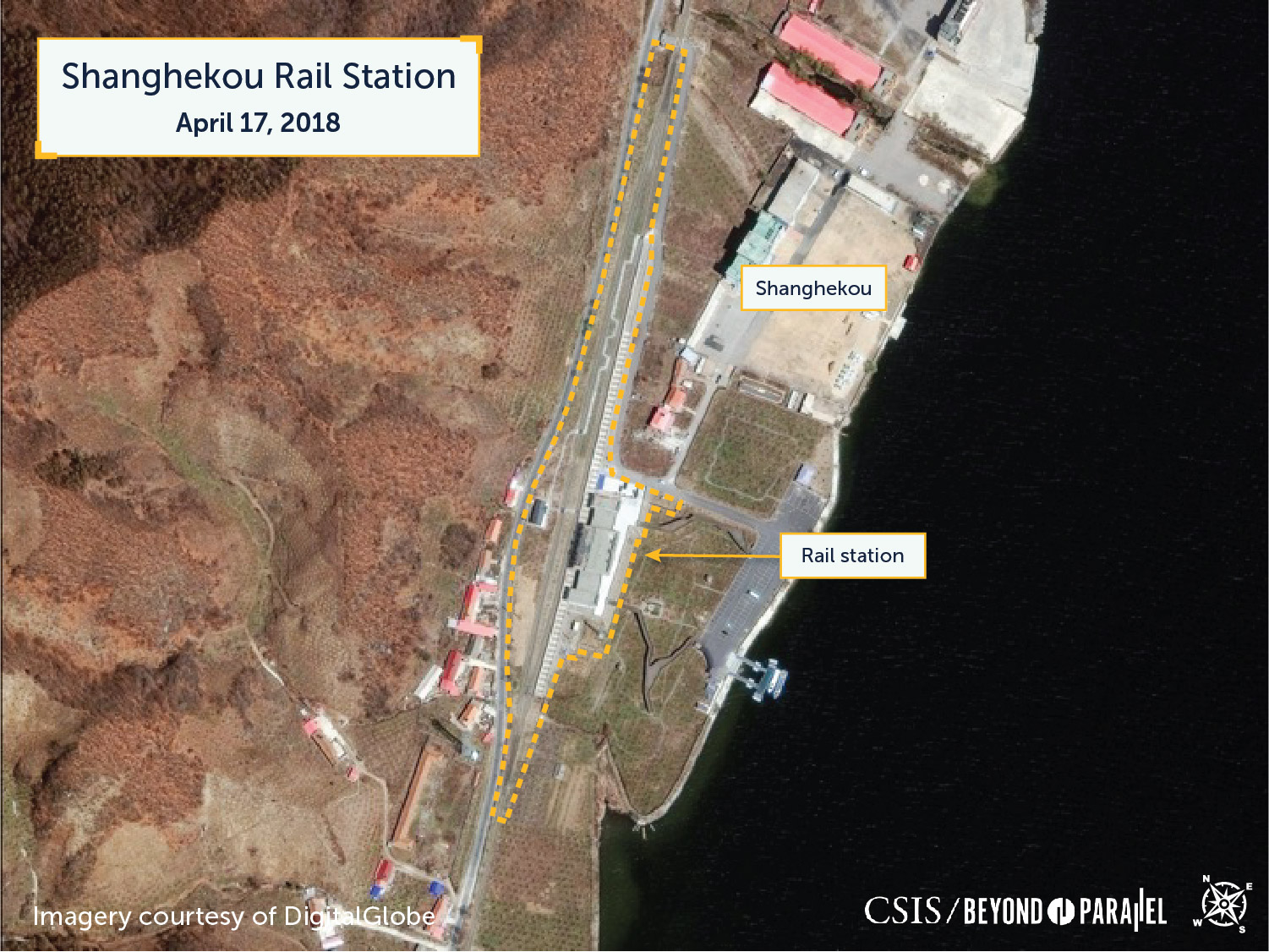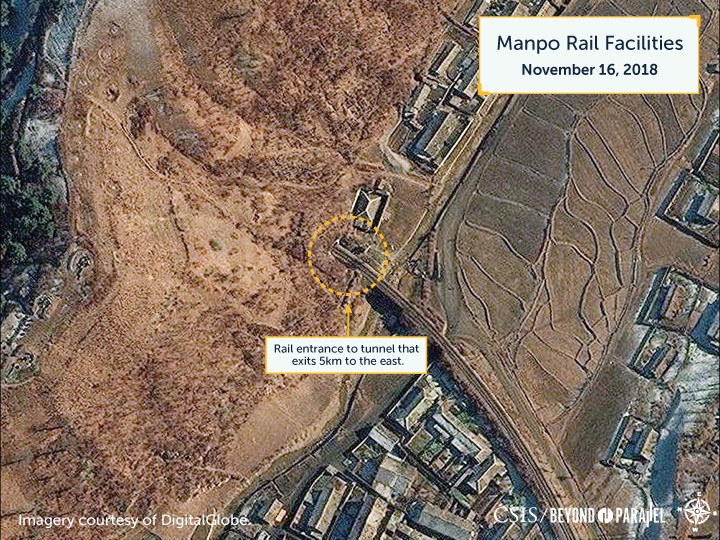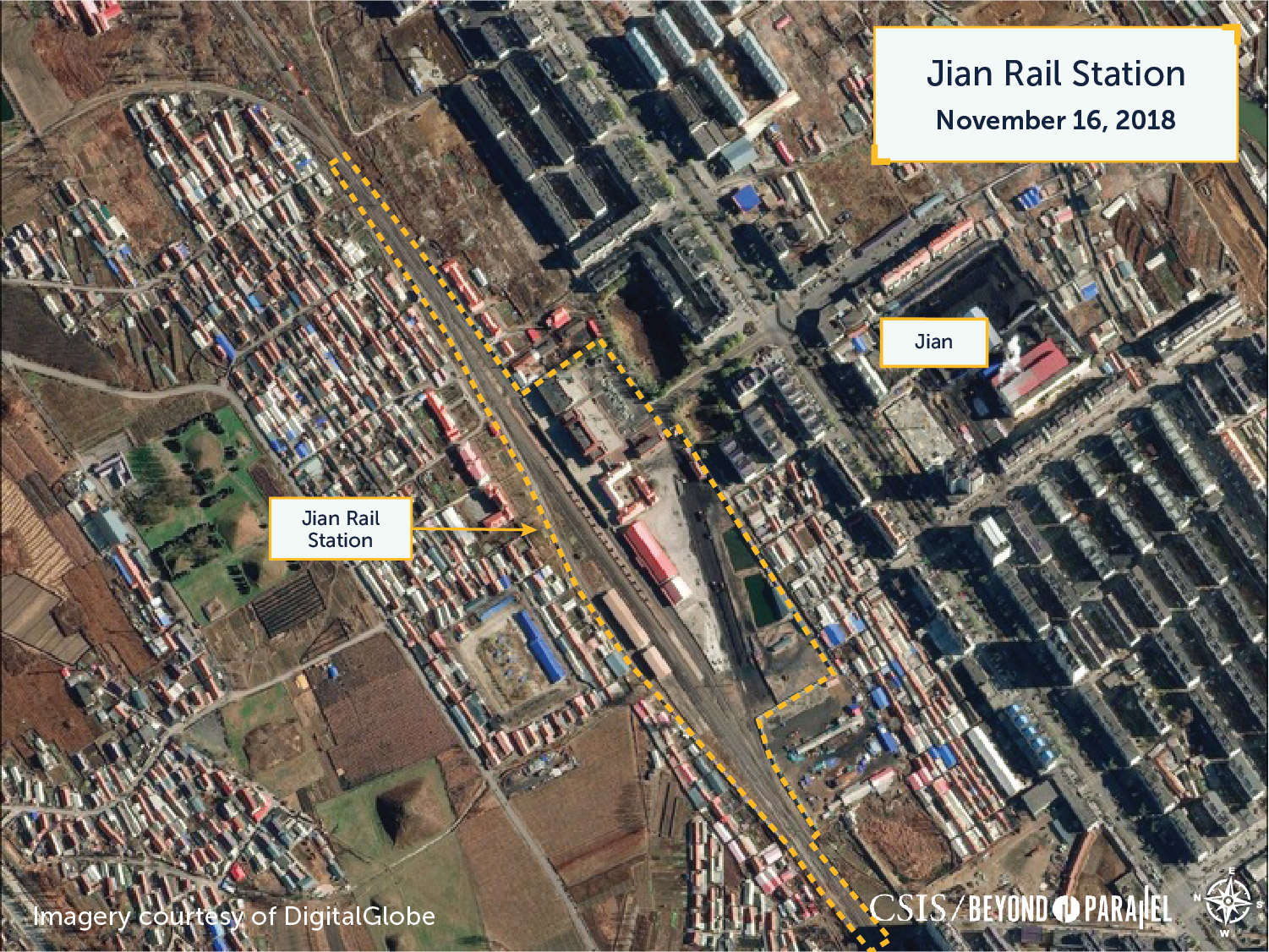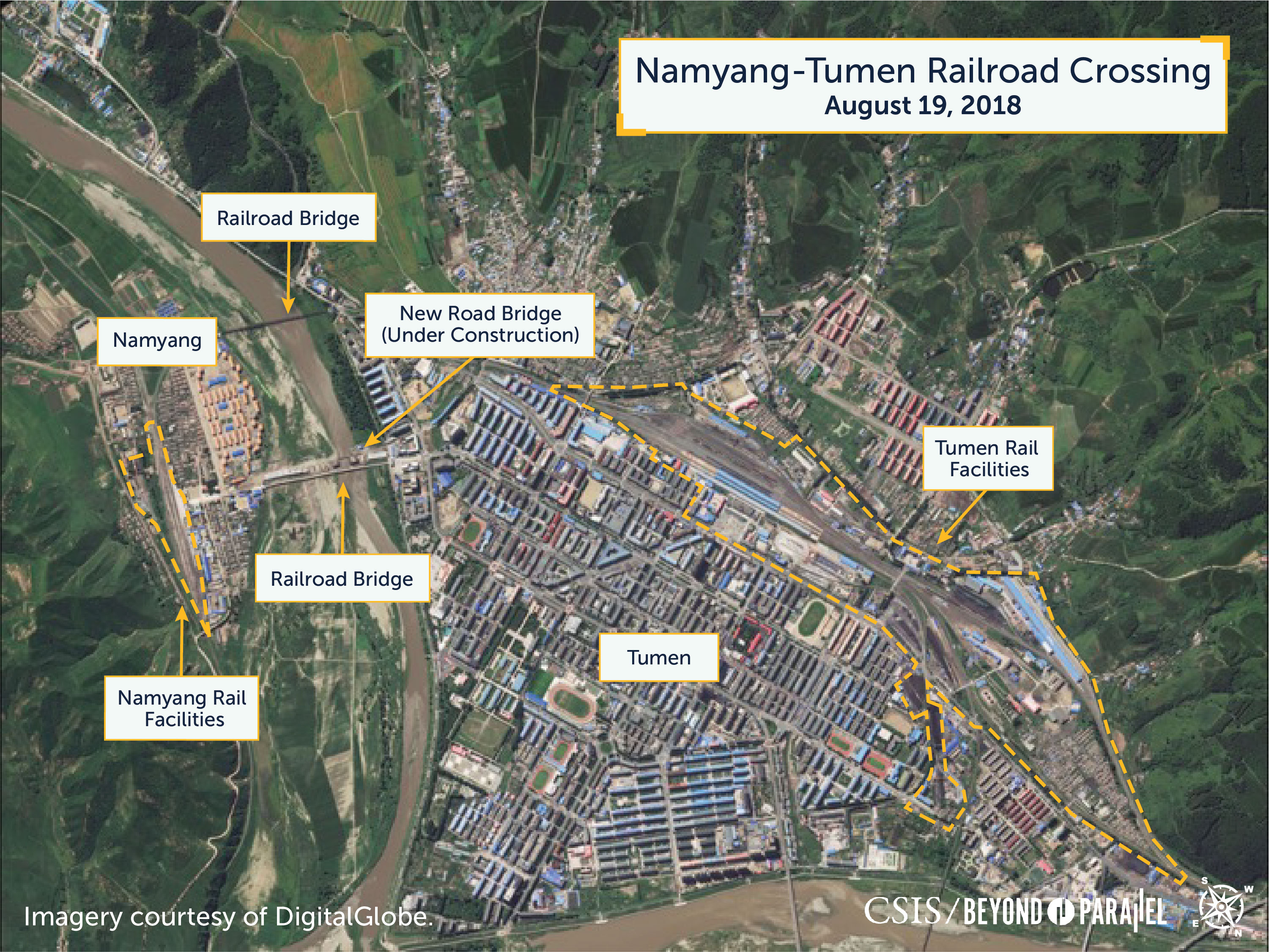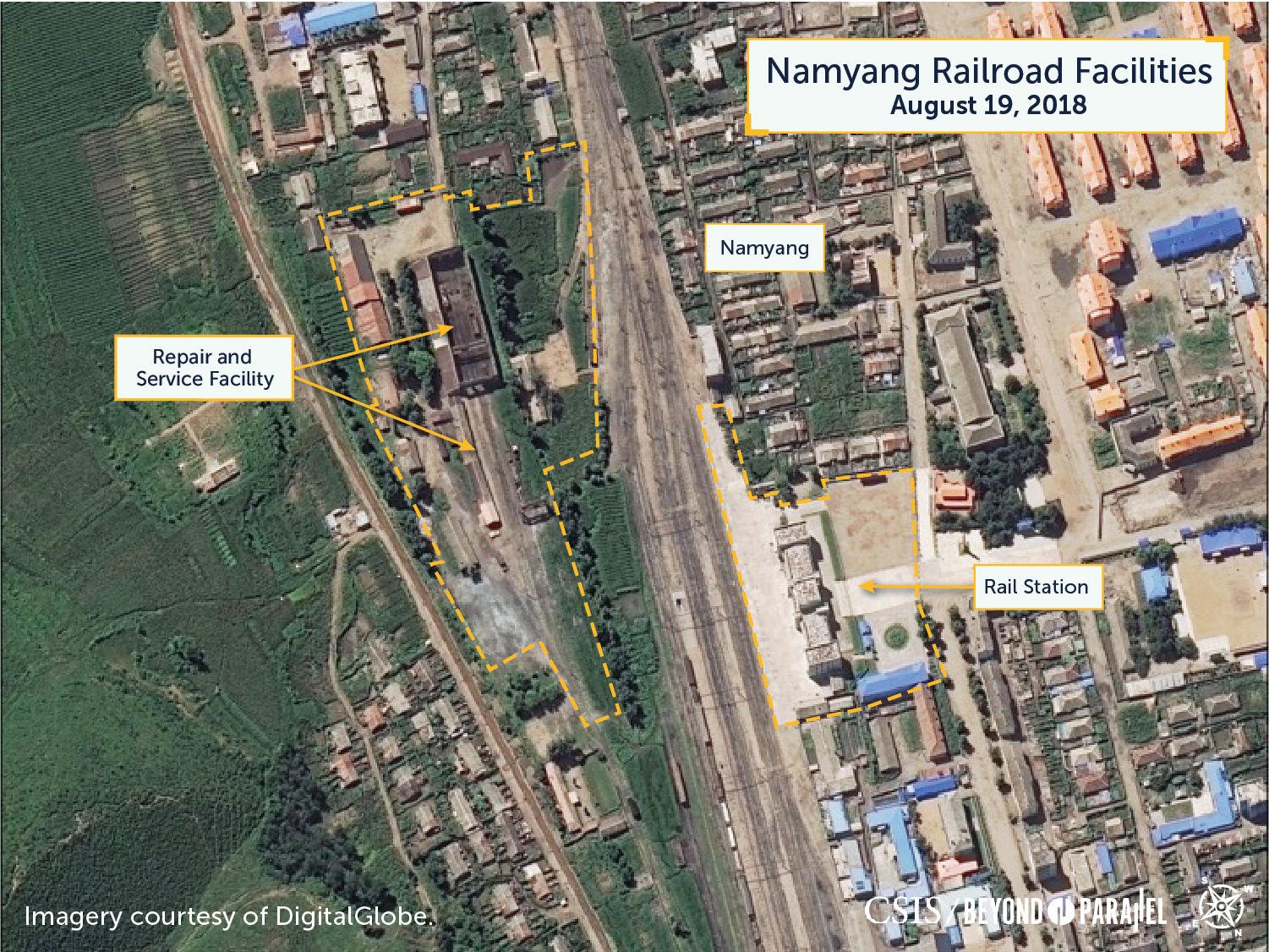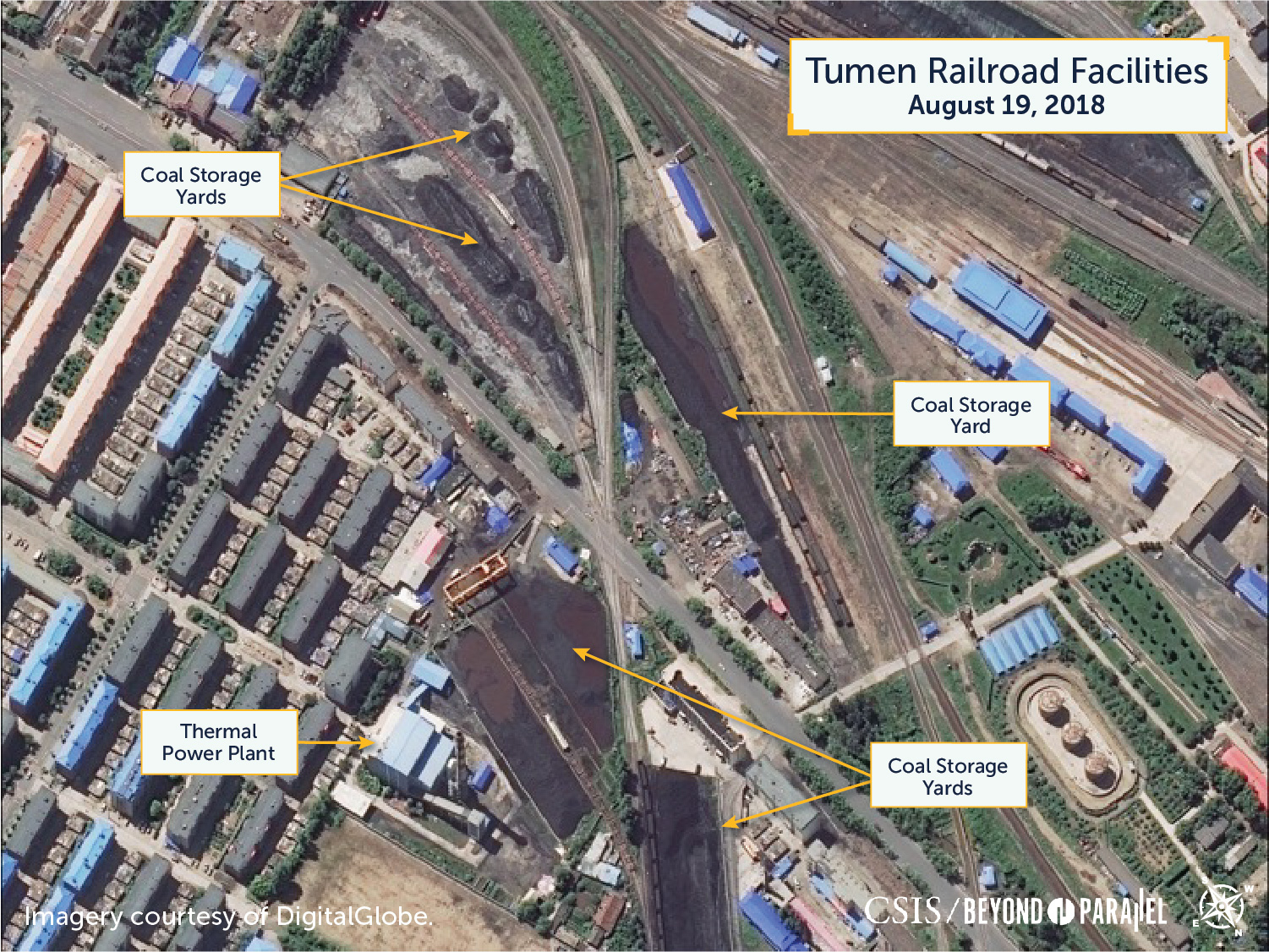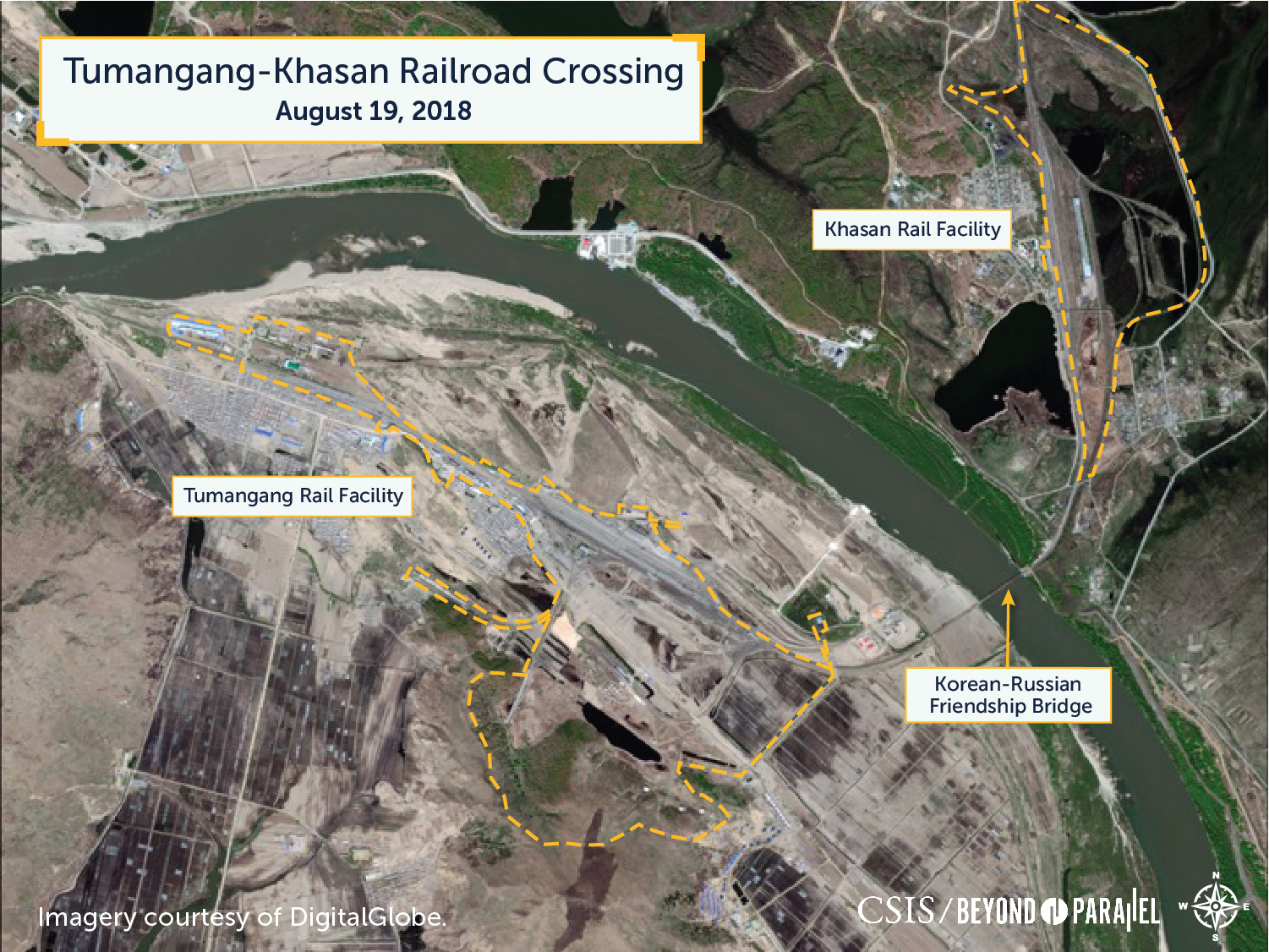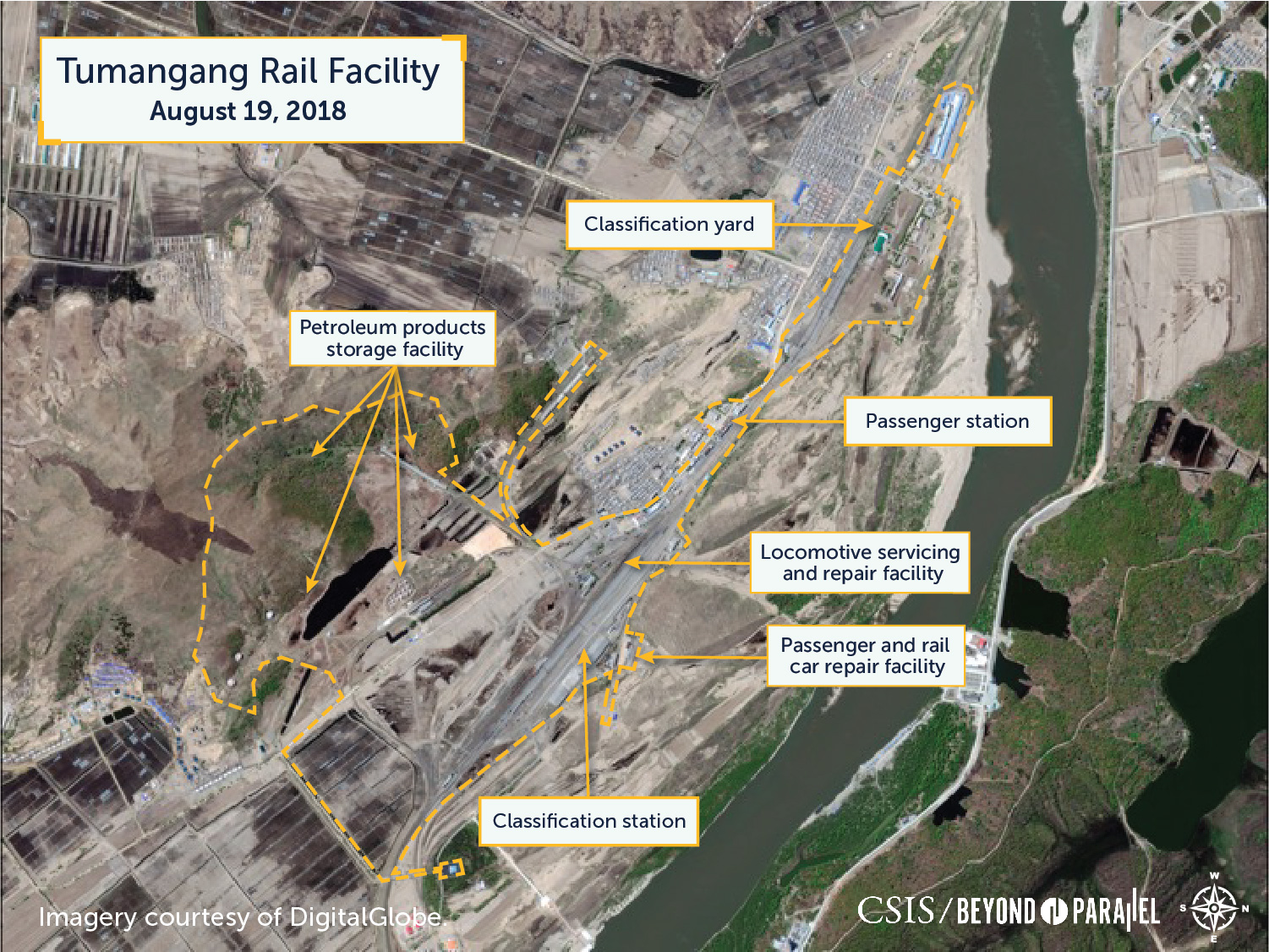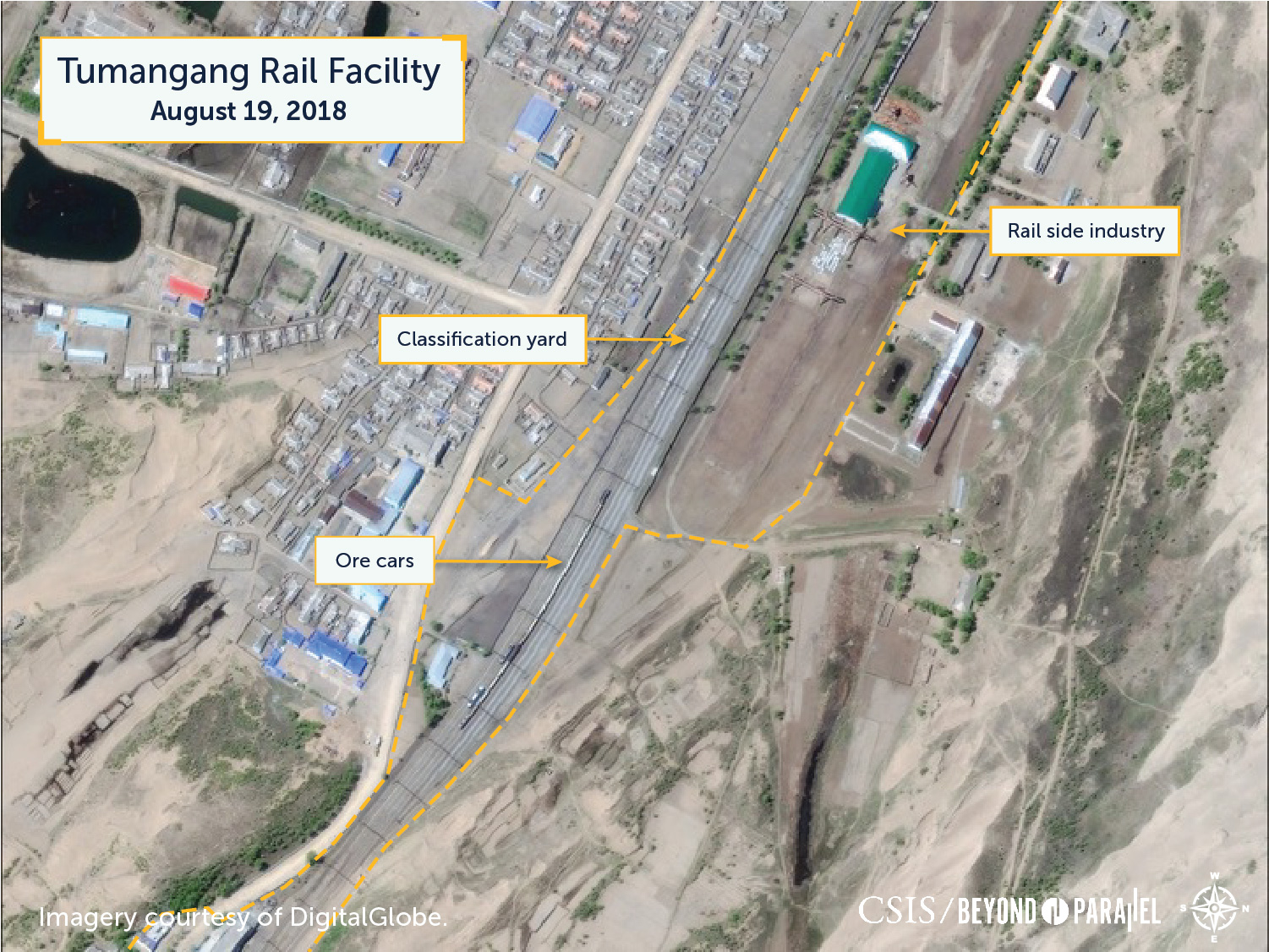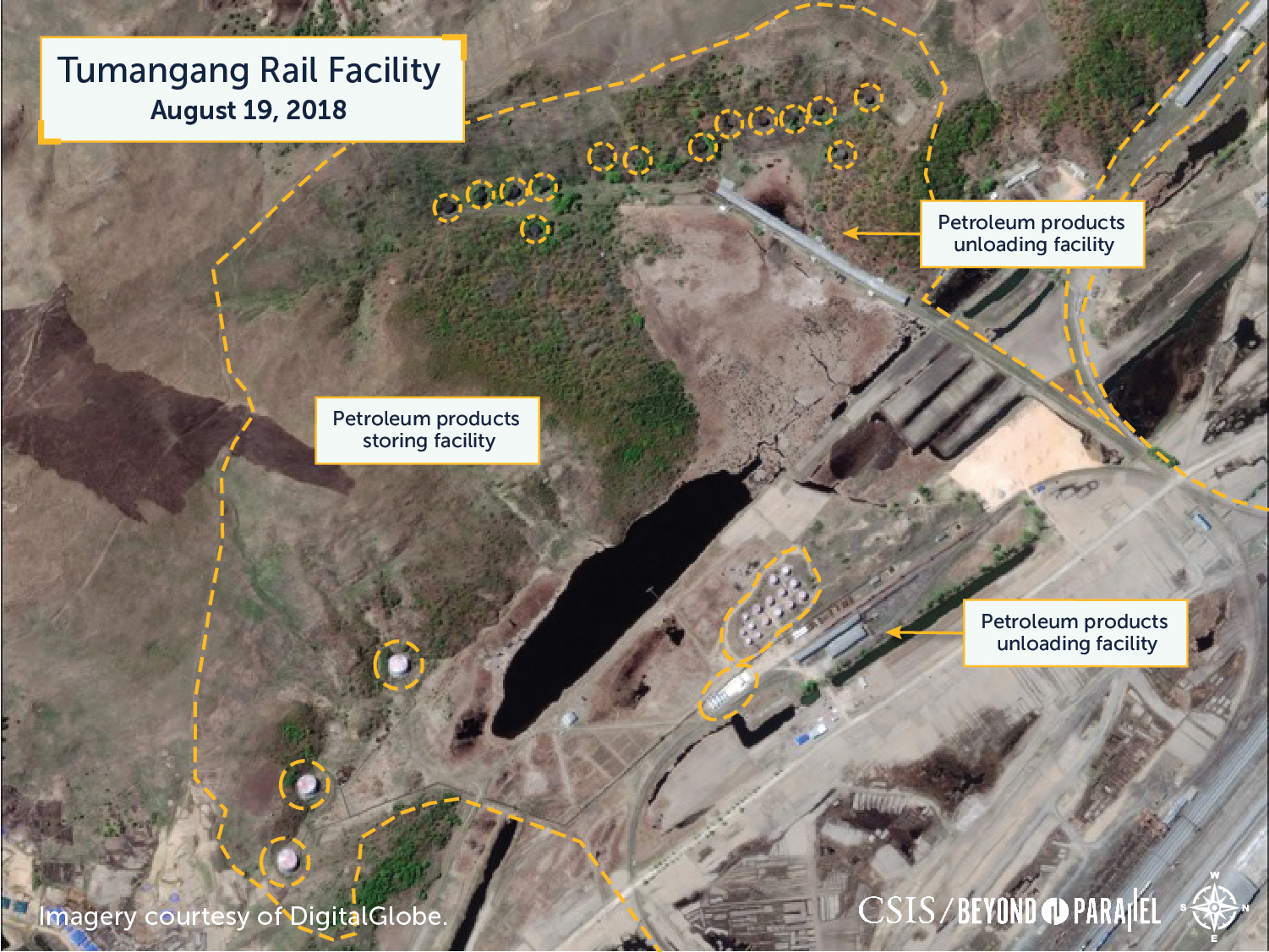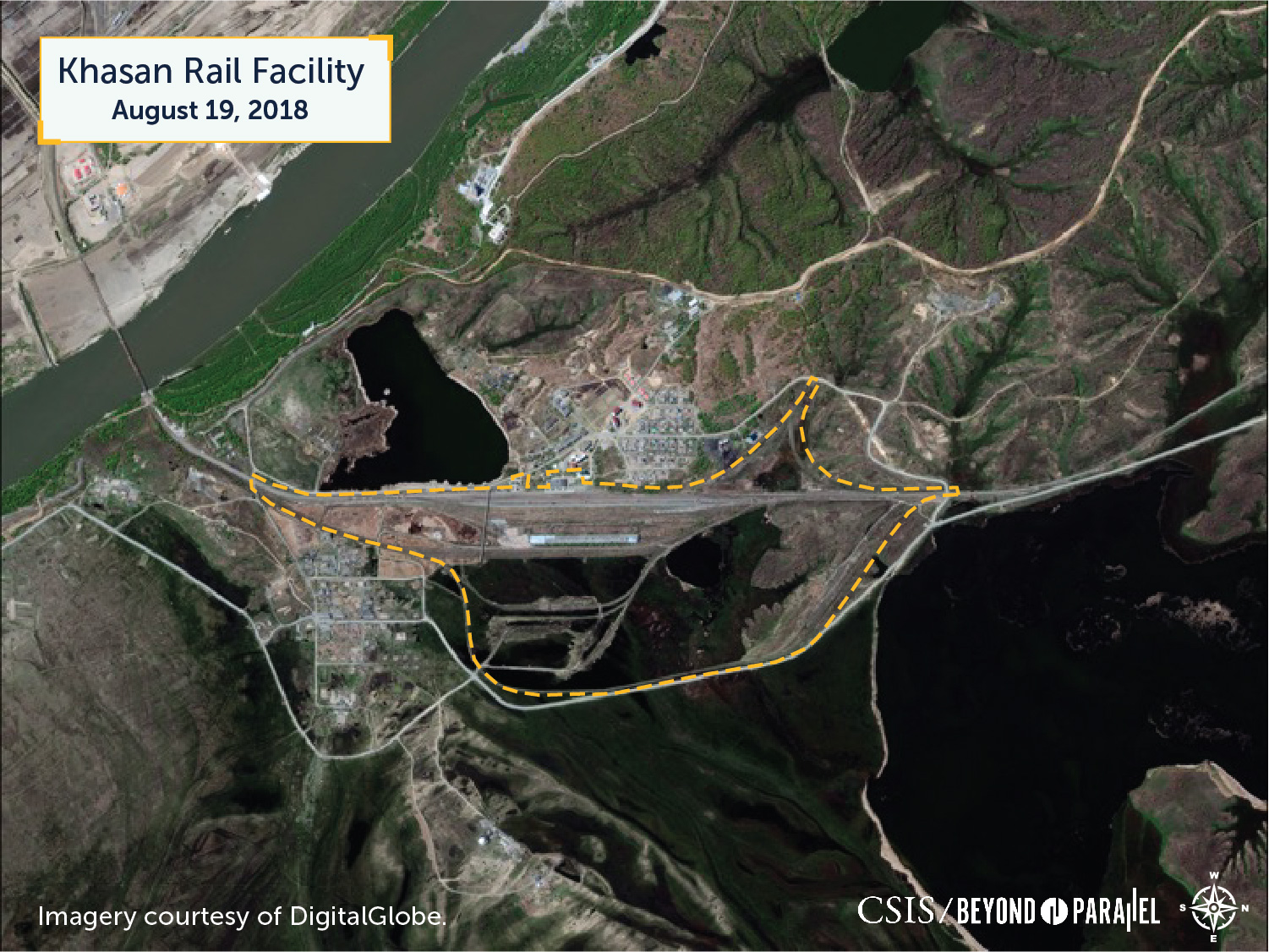
Making Solid Tracks: North Korea’s Railway Connections with China and Russia
A CSIS Survey Study of Railway Cooperation and Connections on the Korean Peninsula1
Key Points
-
- This report is the second in a series of CSIS original reports on the inter-Korean and Korea-Eurasian railway connections including analysis, satellite imagery, and an overview of technical specifications. (See the Beyond Parallel report on the two North Korea-South Korea rail connections for more on inter-Korean railway cooperation.)
- With the December 26 groundbreaking ceremony at the Panmun station on the east side of the Kaesong Industrial Complex, North and South Korea are moving forward with inter-Korean railway cooperation as a key engine for advancing inter-Korean reconciliation and building the infrastructure for eventual unification. Railway re-connection would allow the Korean peninsula to be integrated into a rail network spanning the Eurasian continent through China and Russia. Nonetheless, a long and significant modernization process will need to take place to fully integrate the systems in a commercially viable way.
- There is compatibility in South Korea, North Korea, and China’s rail systems, all using a track gauge of 1,435 mm. On the North Korea-China border, two connection points have large classification yards for assembling and reassembling freight trains. A third point has only a small yard.
- Russia, Mongolia, and other Central Asian countries use a gauge of 1,520 mm. Satellite imagery analysis indicates that while the North Korean facility on the Russian border is physically the largest along any of its borders, much of it is either open land or abandoned.
Railway Connections of the Korean Peninsula
Should inter-Korean cooperation result in the re-connection of the railways in North and South Korea, the rail networks of the Korean peninsula can then be joined with those across the Eurasian continent through China and Russia. President Moon has been building on South Korea’s longstanding, albeit intermittent, conversations and aspirational cooperation commitments with China and Russia to plan for future integration of their railway networks.
Once the Korean peninsula’s railways are reconnected, however, a long and significant modernization process will need to take place to fully integrate the systems in a commercially viable way. The Organization for Cooperation of Railways (OSJD) June 2018 approval of South Korea’s membership now allows South Korea to participate in the Trans-China Railway and the Trans-Siberian Railway.2 However, physical track infrastructure varies greatly, signal systems differ, and clearances for stations are not compatible. While South Korea and China use standard 1,435 mm gauge track, Russia uses a gauge of 1,520 mm. 3 The North Korean systems use a range of gauge widths, but 87 percent of its tracks are 1,435 mm. As with the considerations and complications facing inter-Korean connections, supporting infrastructure such as communication, energy grids, and even emergency response systems also need to be modernized and harmonized. These projects will all be costly and time intensive.
There are currently five rail connections between the Koren peninsula and China and Russia.4 These connections and facilities vary considerably in size, capabilities, and operational status. For example, on the North Korea-China border, two connection points have large classification yards for assembling and reassembling freight trains. A third point has only a small yard.
The four rail crossings between North Korea and China are:
• the Sino-Korean friendship bridge connecting the rail station, classification yard, and shops in Sinuiju, North Korea with those in Dandong, China;
• the Chongsu-Shanghekou railroad bridge connecting the rail facilities at Chongsu, North Korea with a rail station in Shanghekou, China;
• the Manpo-Jian railroad bridge connecting the rail station, classification yards, and shops at Manpo, North Korea with the Jian rail station in China; and
• the Namyang-Tumen railroad bridge connecting the rail station, classification yard, and shops in Namyang, North Korea with those in Tumen, China.
The single crossing between North Korea and Russia is:
• the North Korean and Russian rail networks meet at the Korean-Russian Friendship Bridge, which connects the rail station, classification yards, and shops at Tumangang, North Korea with those at Khasan, Russia.
The North Korea-China Railroad Crossing at Sinuiju-Dandong
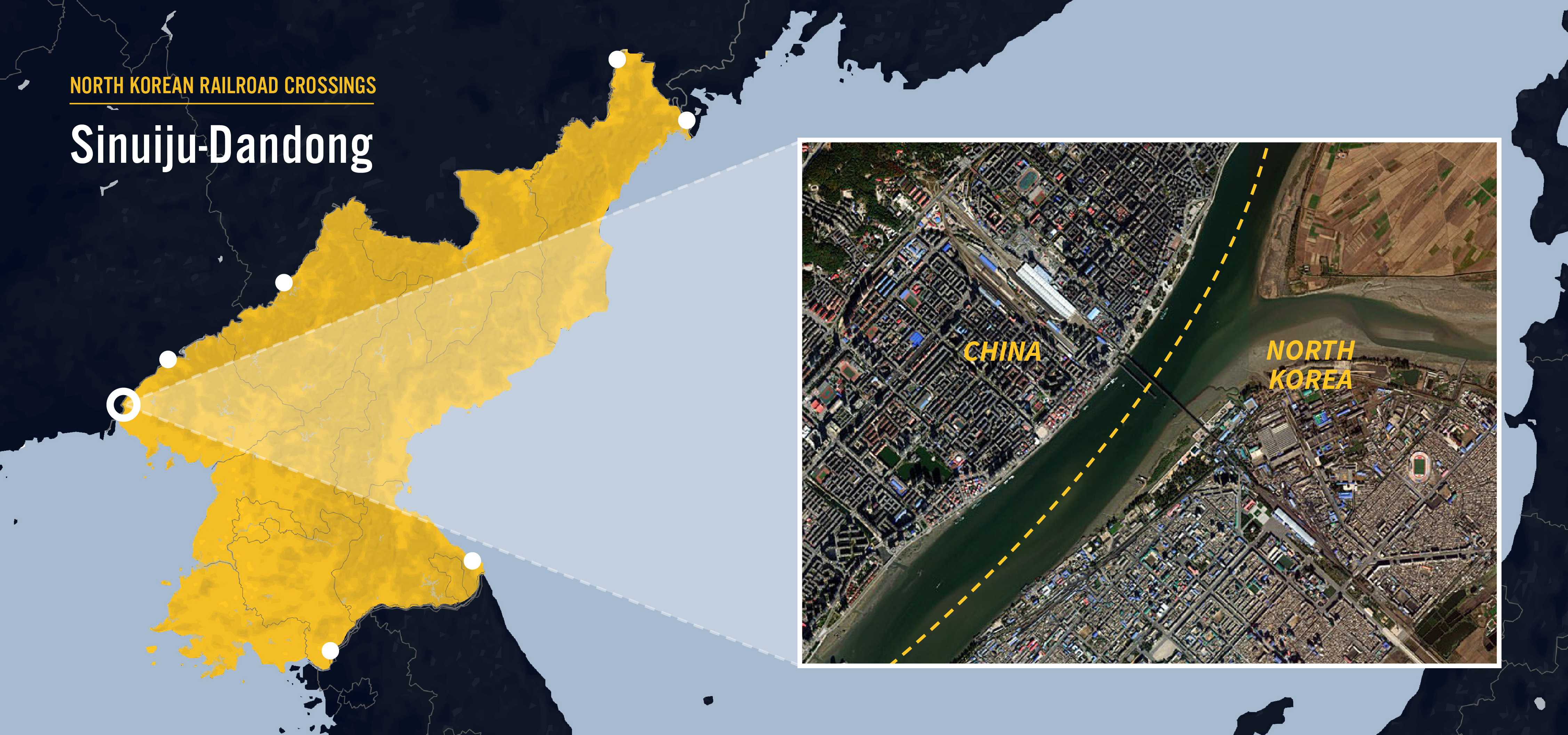
Located on the border with China in the northwest corner of North Korea’s North Pyongan province, the Sinuiju-Dandong railroad crossing connects the North Korean city of Sinuiju to the Chinese city of Dandong. This crossing consists of the Sino-Korean Friendship Bridge (40.115000 124.392500) a combination road and rail bridge across the Yalu River, the Dandong railyards, and the Sinuiju railyards. This is the most well-known and important rail crossing between China and North Korea as it serves as the primary railroad crossing for passenger and general freight between the two countries. This crossing is, therefore, a lead indicator of the level of economic activity between the two countries.
On the North Korean side of the border the Sinuiju railyards are significantly smaller by comparison encompassing only 0.12 square kilometers and consists of:
• a freight classification yard with approximately nine tracks;
• a locomotive and rail car repair and servicing shop;
• a passenger car servicing facility; and
• a covered passenger and freight terminal with approximately four tracks.
A preliminary review of satellite imagery during 2018 shows that, like the Dandong railyards, the Sinuiju railyards are active year-round. However, due to the covered passenger and freight terminal, an accurate accounting of the average number of rail cars present is not practical. The large covered terminals at both Dandong and Sinuiju are the only ones located on the China-North Korea border and are useful in masking the number and types of rail cars (and to a certain extent their contents) moving between the two nations.
Befitting its importance, the rail line from Sinuiju to the North Korean capital of Pyongyang is one of the best maintained and the most modern in the North Korean railroad network.
Taken as a whole, the Dandong railyards encompass approximately 0.44 square kilometers making them the second largest Chinese rail facility on the North Korean border – the largest rail facility is at Tumen, which encompasses 0.9 square kilometers. Among the more significant rail facilities located at Dandong are:
• freight classification and holding yards with approximately 25 tracks;
• a secondary holding yard with two tracks;
• locomotive and rail car repair and servicing shops (many of which are covered);
• extensive warehouse facilities (many of which are covered) and unloading docks;
• extensive rail side industrial facilities; and
• large covered passenger and freight terminal with approximately 16 tracks.
A preliminary review of satellite imagery during 2018 shows that the Dandong railyards are very active year-round, as is to be expected for the Chinese city situated on the primary border crossing with North Korea. They may also provide an evidentiary basis to the claim by experts that China has normalized commerce with North Korea after a period of harsh sanctioning in the last quarter of 2017. An accurate accounting of the average number of locomotives and rail cars present, however, is not practical due to a large number of extensive covered rail facilities (e.g., warehouse and terminals).
While they are known primarily in South Korea and the U.S. as being the focal point of cross border trade between China and North Korea and an overall indicator of China-North Korea relations, the railyards at Sinuiju and Dandong are primarily designed to serve their respective cities. Both of which have large populations and a variety of industries. In both cases the railyards serve as critical rail facilities in their regions with special capabilities (e.g., locomotive, rail car and passenger car repair and servicing facilities, etc.). For Sinuiju, the only comparable rail servicing facilities in North Pyongan province are found at Chonju, far to the south. While the facilities at Dandong are the largest and most comprehensive in eastern Liaoning province.
Regardless of the political-economic conditions in play at any given time, the Sinuiju-Dandong railroad crossing and railyards serve as the primary interchange for trade between the two countries. For North Korea the crossing is critical to its economic and security well-being.
The North Korea-China Railroad Crossing at Chongsu-Shanghekou
Located on the border with China in North Pyongan province, approximately 58 kilometers northeast of the Dandong-Sinuiju crossing, is the Chongsu-Shanghekou railroad crossing (40.458850 124.879464) over the Yalu River. This is a secondary crossing between the two countries that consists of the bridge that connects the small North Korean city of Chongsu to the Chinese town of Shanghekou, rail facilities at Chongsu, and a rail station at Shanghekou.
Approximately 950 meters east of the Chongsu-Shanghekou Rail Bridge is the Chongsu railyard (40.459327 124.890642) that encompass approximately 0.1 square kilometers. The railyard contains a small passenger station with four tracks – two of which are used for freight and coal sorting and storage. In the past there was sizeable locomotive servicing and repair facility here; however, this has been abandoned, and the track was removed prior to 2006. All that remains are the foundation of a turntable, roundhouse, thermal plant, and several support buildings. A refurbishing of these structures, therefore, would be a lead indicator of expanded cooperation in the future.
Located approximately 3.5 kilometers southwest of the bridge is the small rail station at Shanghekou (40.437281 124.850714). This is a minor facility encompassing approximately 0.01 square kilometers consisting of a passenger station with a mainline and passing track and no railyard or servicing facilities.
A preliminary review of satellite imagery during 2017-2018 shows essentially no rail traffic at the Shanghekou rail station and only minor traffic in the Chongsu railyard. This suggests that there is no significant rail traffic at this crossing between the two countries at this time. The minor rail traffic seen at the Chongsu rail facility is likely in support of the city of Chongsu. Such traffic may increase if the reported construction of a nuclear-grade graphite production plant in the city proves to be correct. 5
The Chongsu-Shanghekou railroad crossing is a secondary point of interchange between North Korea and China. The small rail station at Shanghekou and the declining facilities at Chongsu strongly suggest that they do not presently contribute significantly to either nations rail network economy. Due to this crossings remote location, it is likely that even if economic cooperation between China and North Korea increases this crossing will remain of secondary importance.
The North Korea-China Railroad Crossing at Manpo-Jian
Located on the border with China, approximately 35 kilometers northwest of the Kanggye, is the Manpo-Jian railroad crossing (41.155090 126.273282) in Chagang province. This crossing consists of both the Manpo-Jian railroad bridge and, 1.2 kilometers to the northeast, the Manpo-Jian road bridge. Both bridges connect the small North Korean city of Manpo to the much larger Chinese city of Jian.
On the North Korean side of the border, the Manpo railyard is located 750 meters southeast of the rail bridge and encompasses 0.14 square kilometers – making it physically the largest North Korean rail facility on the Chinese border. The facility consists of:
• a freight classification yard with approximately four tracks;
• a passenger terminal with four tracks;
• two storage/holding yards – one with four tracks (tank cars) and the other with six tracks (passenger • and freight cars); and
• large locomotive and rail car repair and servicing shops consisting of a repair building, roundhouse, turntable, thermal plant, and several support buildings.
A preliminary review of satellite imagery shows that the Manpo rail facility is relatively active year-round with approximately 90-125 locomotives and rail cars of various types present at any given time; however, a number of these in the holding yards appear to be in storage or retired in place as they haven’t moved in years.
Located on the Chinese side of the border, 6.8 kilometers west of the railroad bridge, is the small Jian rail station. The station encompasses approximately 0.1 square kilometers and consists of:
• a passenger station and small freight classification yard with seven tracks; and
• several freight warehouses and unloading docks.
The Jian rail station has no significant rail servicing or repair facilities.
A preliminary review of satellite imagery during 2018 shows that the Jian passenger station and small freight classification yard are active year-round, as is to be expected for a small Chinese city, with an average 10-25 locomotives and rail cars of various types present at any given time.
While considered a secondary crossing, the Manpo-Jian railroad crossing appears to be an important rail and road connection between China and the North Korean industrial cities of Kanggye and Pyorha-ri, and Chonchonall of which are involved in military-related production. Therefore, this connection, and the volume of traffic through it, could be considered a lead indicator of an upturn in China-North Korea commerce.
The North Korea-China Railroad Crossing at Namyang-Tumen
Located on the border with China, in the furthest northeast corner of North Korea, is the Namyang-Tumen railroad crossing (42.949050 129.849236) in North Hamgyong province. This crossing consists of both the Tumen railroad bridge (Tumen-gyo) and, 600 meters to the northeast, the Tumen road bridge (Tumen-taegyo). Additionally, a new larger road bridge has been under construction since 2016. The bridges connect the small North Korean city of Namyang to the much larger Chinese city of Tumen.
On the North Korean side of the border, the Namyang railyard is both tiny and rudimentary by comparison encompassing only 0.12 square kilometers and consists of:
• a freight classification yard with approximately nine tracks;
• small rudimentary locomotive and rail car repair and servicing shop;
• one small coal storage yard;
• a passenger terminal; and
• a passenger car servicing facility.
A preliminary review of satellite imagery during 2018 shows that although small the Namyang rail facility is relatively active year-round with an average of 42 locomotives and rail cars of various types present. As with the Tumen rail facilities, over 90 percent of these are ore carrying cars.
Taken as a whole, the Tumen railyards encompass approximately 0.9 square kilometers making them the largest Chinese rail facility on the North Korean border. In comparison, the second largest rail facility is at Dandong and encompass only 0.4 square kilometers. Among the more significant rail facilities at Tumen are: 6
• a freight classification yard with approximately 20 tracks;
• extensive locomotive and rail car repair and servicing shops;
• an intermodal yard (rail-to-truck);
• eight coal storage yards (two of which are for power generation);
• two passenger terminals;
• a passenger car servicing facility; and
• numerous freight warehouses and unloading docks.
A preliminary review of satellite imagery during 2018 shows that the Tumen railyards are very active year-round as is to be expected for a Chinese city situated on an important border crossing with an average in excess of 500 locomotives and rail cars of various types present; however, over 90 percent are ore carrying cars.
The Tumen railyards are primarily designed to serve Tumen city and the Yanbian Korean Autonomous Prefecture in general. The railyards consist of a wide range of facilities (e.g., locomotive and rail car repair and servicing shops, passenger car repair and servicing facilities, intermodal yard, etc.) that compliment rather than supplant those found in nearby Yanbian, Hunchun and Wangqing. To a significantly lesser degree, and under favorable political-economic conditions, the Tumen railyards serve as an important railroad interchange for trade with North Korea.
The proximity of the Namyang-Tumen crossing to the ore mines in North Hamgyong province and the presence of seven coal yards among the Tumen rail facilities are notable and suggest that this is one of the primary land routes for the export of coal from North Korea to China. Therefore, it is a lead indicator of the volume of bilateral business between the two in extractive industries. In addition, should overall economic cooperation between China and North Korea increase, it is logical that the Tumen railyards will be the primary port of entry for goods moving between the Rason Special Economic Zone (specifically the port of Rason [Najin] 88 kilometers to the south). Despite considerable Chinese investment in Rason in the past, a preliminary examination using satellite imagery of rail activity and shipping movements at the port during 2018 does not indicate any significant activity that would suggest significant Chinese use of the port.
The construction of a new road bridge that began in 2016 is an additional indicator of the importance of the Namyang-Tumen railroad crossing to both countries.
The North Korea-Russia Railroad Crossing at Tumangang-Khasan
Located on the border with Russia, in the northeast corner of the country on the Tumen River, is the Tumangang-Khasan railroad crossing (42.415397 130.641489), in North Hamgyong province. The crossing consists of the Korean-Russian Friendship Bridge, Tumangang railyard and Khasan railyard. This is North Koreas sole railroad crossing with Russia and is of great potential importance due to its proximity to the port city of Rason (Najin) in the Rason Special Economic Zone, 33.5 km to the southeast. Although a railroad bridge across the Tumen River has been at this location since the colonial days, the current Korean-Russian Friendship Bridge replaced that bridge in 1959.
The Tumangang railyard (42.417307 130.618461) encompasses approximately 2.5 square kilometers making it the nations largest rail facility connecting to any country. It serves as the gateway for all rail shipped goods between North Korea and Russia, but more importantly is the point where goods are transferred from Russian-gauged rail cars to Korean-gauged rail cars. Among the more significant rail facilities located here are:
• two large classification and storage yards with approximately 10 tracks and 8 tracks respectively;
• locomotive, rail, and passenger car repair and servicing shops;
• a passenger terminal;
• numerous freight warehouses, unloading docks, open-storage areas, and rail-side industries; and
• a dispersed, but sizable, petroleum products storage facility with approximately 33 storage tanks. 7
A preliminary review of satellite imagery during 2018 shows that the Tumangang facilities are active year-round as is to be expected for a railyard situated on both the major rail line serving the northeast corner of the nation and an important border crossing. Approximately 45-80 locomotives and rail cars of various types are present at any given time. Of these, 40-50 percent are tank cars suggesting that the petroleum products storage facility is a major source of rail traffic. Therefore, this railway node is probably the most transparent lead indicator of Russian energy assistance to North Korea. It is unclear, however, how much of the rail traffic at the Tumangang railyard is related to trade with Russia.
Encompassing 1.2 square kilometers, the Khasan railyard (42.430654 130.645571) is physically the largest along any border with North Korea. Much of it, however, is either open land or abandoned. About the only facilities currently operational here are:
• a freight classification yard with approximately nine tracks;
• a passenger terminal; and
• some small support buildings.
A preliminary review of satellite imagery during 2018 shows that the Khasan rail facility is active year-round, however, there are wide swings in the number of locomotives and rail cars of various types present. These swings can vary from just 2 to over 200. When larger numbers are present over 95 percent are ore (most likely coal) carrying cars.
The proximity of the Tumangang rail facility to the large coal mines in North Hamgyong province and the presence of large numbers of coal cars in the Khasan rail facility are notable and indicate that this activity is related to the Russian importing of coal from North Korea. Should economic cooperation between Russia and North Korea increase, it is logical that this trade will increase, and the Tumangang rail facility will expand into the primary port of entry for goods moving between the two countries. Russian goods could eventually be exported from the Rason Special Economic Zone (specifically the port of Rason [Najin]) and, if the rail connections are made, to the South Korean ports of Pohang and Busan.
References
- The authors wish to thank Sea Young (Sarah) Kim of the Georgetown University MA in Asian Studies program and the CSIS Korea Chair for her invaluable research in support of this project. ↩
- Sung-Wook Nam, Sang-Woo Rhee, Myongsob Kim, Young-Ho Kim, Yong-Sub Han, Young-Soon Chung and Seong-Ok Yoo, South Korea’s 70-Year Endeavor for Foreign Policy, National Defense, and Unification, Academy of Korean Studies, 2019): 69. ↩
- Suk Hi Kim, The Strategic Role of North Korea in Northeast Asia, in Suk Hi Kim, Terence Roehrig and Bernhard Seliger (eds.), The Survival of North Korea: Essays on Strategy, Economics and International Relations (Jefferson, NC: 2011), 72. ↩
- The names of the crossing and rail facilities used here should not be considered definitive. ↩
- David Albright, Chongsu Nuclear-Grade Graphite Production Plant? (Washington, D.C.: Institute for Science and International Security, 2018), http://isis-online.org/isis-reports/detail/chongsu-nuclear-grade-graphite-production-plant/. ↩
- The area encompassing the Tumen railyards and facilities does not include those at Qushuicun, 2.5 kilometers to the north. ↩
- Although none have been identified in recent satellite imagery, it is not unusual for petroleum products storage facilities to have underground storage tanks. ↩



